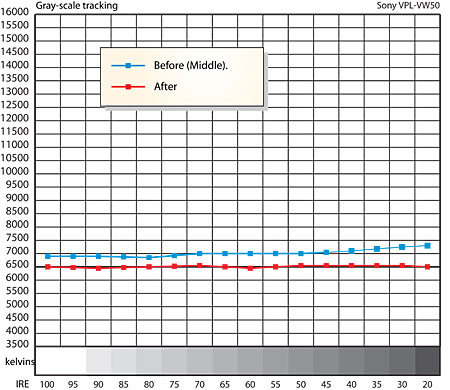Sony VPL-VW50 "Pearl" Projector SXRD Projector Measurements
One of the first things we do when measuring a projector is put up a white crosshatch pattern (at 1080i in this case) and take a look at geometry and look for any chromatic aberrations in the optics and, in the case of a three-chip projector like this one, misalignment of the three imaging chips. The most obvious sign of these things is color fringing around the white lines of the crosshatch, and you can also tell something by how crisply defined the pixel structure on the crosshatch is. We expect some degree of imperfection here, but generally don't get critical as long as the fringing isn't more than a pixel in width and is confined to the sides of the image, which is typical.

On the Pearl, the color fringing was held to within a pixel or so, but it was all over the screen, even at the center, and often there was more than one color peeking out at the sides of the white lines of the crosshatch. Also, the Pearl's pixel structure is noticeably softer than with the single-chip DLPs, such as Marantz's VP-11S1, which means focus uniformity isn't a strength here either. The Marantz also showed practically no color fringing on the crosshatch, but one could make the argument that it darned well shouldn't for $20K.
Nevertheless, I believe this has a lot to do with the Pearl's slightly softened, but also smooth and naturally detailed image. Speaking of the detail, looking at the single-pixel width, 37.1MHz area of a 1080i luma burst via HDMI, the Pearl does show a clear line structure that's just slightly gray compared to the crisp, sharp white lines I saw from Marantz's VP-11S1 and Pioneer's PRO-FHD1 plasma, the two best performers I've seen on this test. This suggests that while the bandwidth and resolution is there, it's just rolled off in amplitude by a hair.
Any or all of these results could be related to the chromatic aberration and/or panel misalignment discussed above, or something completely different. Nevertheless, the measurements do show that the Pearl is a bit soft and that you do get something from spending much more on a projector.
Sticking with the crosshatch, I did see some slight bowing, or barrel distortion on the top lines but not enough to make more than this passing comment on. It was not noticeable with program material. There was no more than 2% overscan at 480p, 720p, or 1080i over HDMI.
Moving to a 1080i chroma burst via HDMI, I saw the same performance as with the luma bursts- a clear line structure with just a little softening at the very top frequencies. Ditto 720p over HDMI- the top frequencies in the luma and chroma bursts were slightly soft. At both 720p and 1080i over HDMI the double-pixel wide, 18.5MHz areas of the bursts were perfect. There was no noise, banding or moiré at any frequency, indicating very clean performance.
Switching up to component video, the 1080i bursts were even softer still at the top frequencies, with less distinctive line structure. However, 720p was nearly perfect at the single-pixel width, 37.1MHz area of the luma burst, and just a little better than with HDMI. Surprising, that!
With grayscale tracking, the Pearl was a dream. Its out of the box performance was excellent, centering around 7000K through the range and only erring toward a benign amount of blue. For the perfectionists out there it calibrates quickly and nearly perfectly. Tracking was exceptionally tight on the D65 target, which is even more critical than the temperature readings themselves. The Pearl didn't deviate from the x/y targets for D65 by more than .002 from 30 IRE to 100 IRE, and unlike many displays it maintained that tracking down to black. Exemplary. We couldn't ask for more.





























































